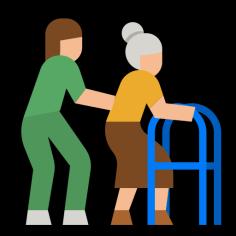






















Average scores, all responses
Average scores, DASSs and ADs
Q1. Vision: We have a shared vision and ambition across health and care partners to move from a reactive /crisis model to a proactive/preventative model –enabled through digital and data.
Q2. Digital: We are digitally mature; we have strong digital foundations in place upon which we can deliver innovative digital solutions. Our digital infrastructure (systems and tools) are interoperable where required. We have deployed digital solutions across the person’s journey through social care (from front door to long term care).
Q3. Data: We have joined up and shared data of the person across the system that is accessible at the right time to help staff make the best decisions. We are intelligence led in all that we do.

Q6. Co-production: Our delivery puts residents at the centre of decision making, design and planning. We work to include the voice of residents and build in equality, diversity and inclusive considerations to help to influence and shape our approach.

Q7. Quality: People who use services should be able to expect person centred care that is safe, effective, caring and responsive. This care is supported by good leadership and sustained by good use of data and technology enabled care.
Q4. Technology enabled care (TEC): We have delivered TEC at scale and are able to use the new data insights this creates to identify escalating needs and prevent crises.

Q5. Workforce: our frontline staff are digitally confident, with high levels of digital literacy and are using digital tools to be more efficient and deliver high quality care. We understand that digital transformation is more about cultural change than technical solutions.


Q8. Safety: We understand the risks, challenges and opportunities in how our use of data, TEC and digital approaches impacts on the key people, relationships, values and systems in place keeping the people we serve safe.

Q9. Collaboration: We get the most value from our digital solutions by working collaboratively across services, departments and organisations in the design and implementation of those solutions.

Q10. Delivery: We have the internal resources, capability, and capacity to deliver this new digital future at the pace required. The conditions are in place to deliver a digital future at scale e.g. system leadership, culture, front-line staff engaged in the change process.


All foundations for delivering reimagined model of digitally enabled health and care need significant improvement. There is work to do across all areas for successful transformation. It needs a strategic / holistic approach – not siloed work or tech-focused pilots.
- Average score across 10 questions is 5.8 (and 5.4 for DASS/AD cohort).
- Only one area scored above 7 - Quality.
- Lowest score was Digital with 4.9.
Traditional areas are where the sector has made most progress, is best-placed or most confident.
- Areas with highest scores include Quality, Co-production, Safety, Vision and Collaboration. Digital and technology are the weakest areas and need the greatest focus – they provide the greatest opportunity for step change in impact.
- Lowest scoring areas included:
- Digital (4.9)
- TEC (5.0)
- Workforce (5.1 – which is about digital literacy / confidence)
- Data (5.2)
- Delivery (5.4)
DASS and AD scores are lower, with the four digital / tech questions all being below a score of 5.

Conditions are not yet in place across the board
– investment and focus are required to deliver a sustainable model of health and care.

Traditional areas are stronger, but we need to build digital / delivery capability.
- Digital (4.4), Data (4.9), TEC (4.5) and Workforce (4.1).

There is limited regional variation overall – although some specific themes seem stronger in some regions than others.

DASS / AD views show less positivity and confidence.

